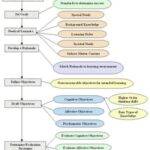All of the water in the Earth system continually cycles from oceans, lakes and rivers up into the atmosphere and back again to Earth’s surface. In this lesson plan, students will understand what drives the water cycle and how water moves from one stage of the water cycle to another.
Direct Instruction
Begin a class discussion by asking students what happens to water on the sidewalk when the sun comes out after it rains. They may say that it dries up. Ask where the water goes when it dries up. Explain that the water does not simply disappear, but changes from a liquid to a gas and rises into the air. The changing of phase from liquid to gas is called evaporation. Evaporation requires energy. Where does the energy come from? Energy in the form of heat from the sun causes liquid water to evaporate and become water vapor in the atmosphere. Water in the oceans, lakes and rivers is constantly evaporating and entering the atmosphere.
Ask students what they think happens to the water vapor when it is high in the atmosphere. Molecules of water vapor become cool and cling together to form drops, and this is how clouds are formed. This process is called condensation.
Ask students what happens to the water in the clouds. When the water drops in the clouds get too large, they fall back to Earth as rain or snow. This process is called precipitation.
As a review, ask students to name and define the steps of the water cycle, and write them on the board or overhead.
Evaporation- when water changes from a liquid to a gas and rises into the atmosphere
Condensation- when water vapor condenses to form drops as clouds
Precipitation- when water falls back to Earth’s surface in the form of rain, snow, sleet or hail.
Demonstrations
A terrarium can be used to demonstrate the stages of the water cycle. To make a terrarium, take a glass or clear plastic jar and place a layer of potting soil on the bottom. If desired, seeds can be planted in the soil. Wet the soil thoroughly and cover the top with plastic wrap. Close it securely with a rubber band. Set the container in a warm sunny window, or if no window is available, place it under a heat lamp or grow light. Have students observe the terrarium every day. Water from the soil will begin to evaporate, and collect on the plastic as condensation. Eventually, it will fall back down again as precipitation.
For a simple demonstration of how clouds are formed, see the AC article, How to Make a Cloud in a Bottle.
Other elements of the water cycle can be included for older students. These include transpiration, the release of water vapor into the air from the leaves of plants, and runoff, which is water running over the surface after a heavy rain. Water from runoff returns to streams and rivers, and eventually goes back to the ocean.
Sources:
http://www.get2knowh2o.org/instructor/teach3.pdf
Tarbuck, Edward J. and Lutgens, Frederick K. Earth Science 11th ed. Pearson Prentice Hall, 2006.



